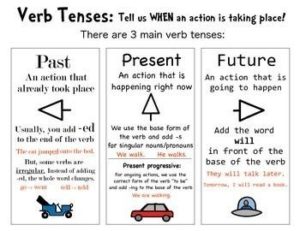In order to use these tenses correctly and meaningfully, one must remember to follow a couple of rules. While some may be obvious, the others need to be taken care of. The rules that govern the usage of tenses are known as Sequence of Tenses or Agreement of Tenses. Are you getting curious to know these rules? Well, let’s read them below!
Suggested Videos
Sequence of Tenses
Tenses are verbs that describe when an event, action or condition has occurred. There are three types of tenses based on the time:
Each of these has 4 aspects which indicate the continuation of the tenses. So, there are in total 12 tenses that are regularly used in English Grammar. Now let us learn the Sequence of Tenses.
One basic rule we must remember at the time of using tenses with principle and subordinate clauses are that the subordinate clause always follows the tense in the principal clause. However, there are exceptions to this rule which we will see as we go by.

(Source: Pinterst)
Rule 1
A past tense in the principal clause is always followed by a past tense in the subordinate clause. Example: I found out that she was out of town.
However, there is an exception to this rule. When the principal clause in the past tense, the subordinate clause can be in the present tense if it is citing a universal truth. Example: The children were taught that honesty is the best policy.
Another exception to this rule is when the word ‘than’ is used in the sentence to introduce the subordinate clause. In this case, we can use any tense with the subordinate clause irrespective of the tense used with the principal clause.
Rule 2
If the tense used with the principal clause is in the present or future tense, the tense of the subordinate clause can be in any tense based on what needs to be conveyed.
Example: She is saying that she is alright. She says she is fine.
Rule 3
When we use the principal clause in the future tense, we do not use subordinating clauses in the future tense and use the subordinating clause beginning with when, until, before, after etc.
Example: I will call you when dinner is ready. I shall wait until you return.
Rule 4
When the subordinate clause is introduced with the conjunction ‘that’, we do the following,
- We use ‘may’ in the subordinate clause when the principal clause is in the present tense. AND
- We use ‘might’ in the subordinate clause when the principal clause is in the past tense.
Example: We eat that we may live. She tried to live so that he might have a chance at life.
Rule 5
When some phrases such as If only, Wish that, What if, It is time are used, the clauses that follow it are always in the past tense.
Example: I wish I could eat another ice cream.
Suggested Topics
- Introduction to Tenses
- Present Tense
- Present Perfect Tense
- Present Continuous Tense
- Present Perfect Continous Tense
- Past Tense
- Past Perfect Tense
- Past Continous Tense
- Past Perfect Continous Tense
- Future Tense
- Future Perfect Tense
- Future Continous Tense
- Future Perfect Continous Tense
- Sequence of Tenses
- Uses of Tenses
Solved Example for You
Q: His health________ since he left the city.
(a) Improved (b) Has improved
(c) Had Improved (d) Could improve
Sol. (b) Has Improved. The word ‘since’ indicates the present tense. The best option to use is ‘has improved’ which is present perfect tense. Therefore, the correct answer is (b).






What is the present perfect form of “He does not smoke”?
What is the difference between “He does not have to smoke” and “He has not smoked”?
Hello